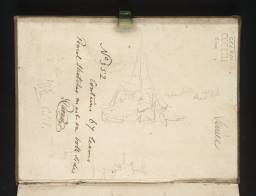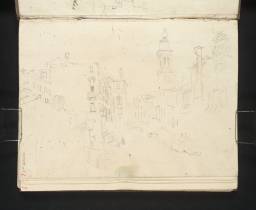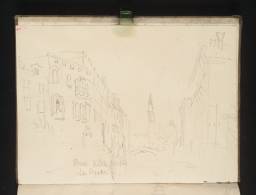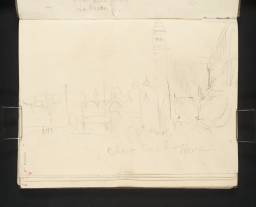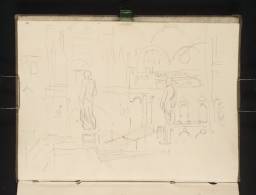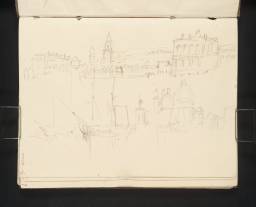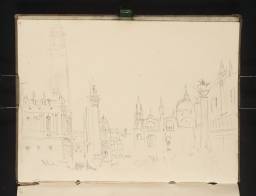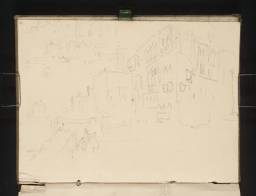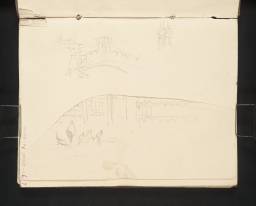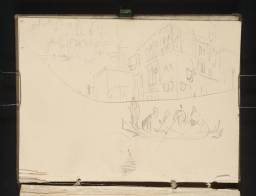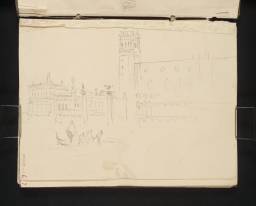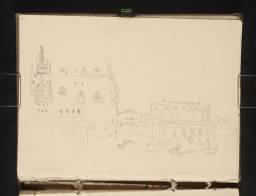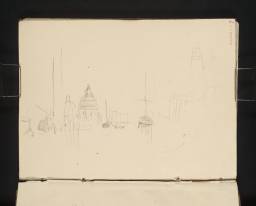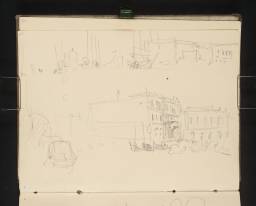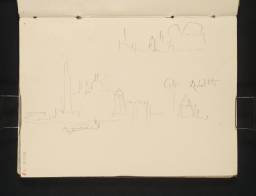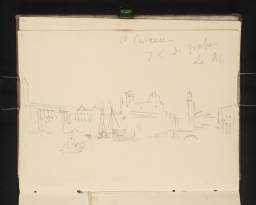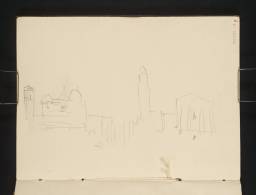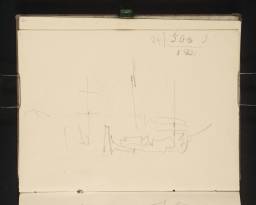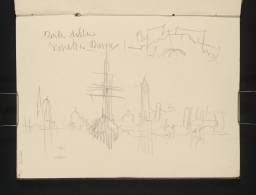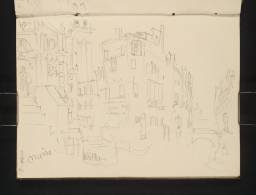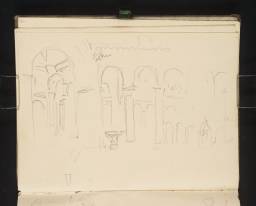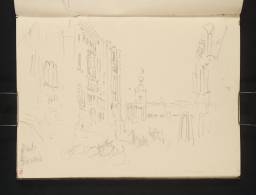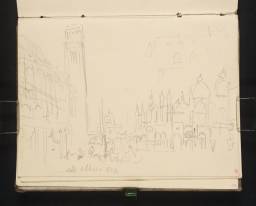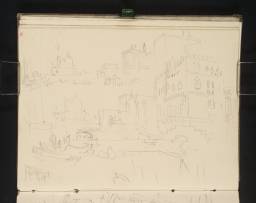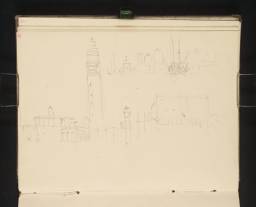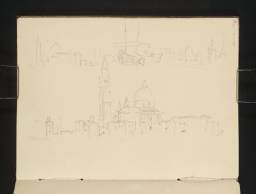Turner Bequest CCCXIII 1–70a
Sketchbook bound in boards, covered in slate grey wove paper; one of three green leather pencil loops remaining
70 leaves of cream wove paper and paste-downs of white laid paper, page size 173 x 123 mm
Unidentified Austrian maker; various leaves partially watermarked ‘J. Wha’ or ‘J. Wh’ and correspondingly ‘tman’ or ‘atman’
Numbered 352 as part of the Turner Schedule in 1854 and endorsed by the Executors of the Turner Bequest inside front cover (D41118)
Blind-stamped with Turner Bequest monogram on front cover, towards top left
Inscribed in pencil ‘CCCXIII’ on front cover, top right
Stamped in black ‘CCCXIII’ on front cover, top right
70 leaves of cream wove paper and paste-downs of white laid paper, page size 173 x 123 mm
Unidentified Austrian maker; various leaves partially watermarked ‘J. Wha’ or ‘J. Wh’ and correspondingly ‘tman’ or ‘atman’
Numbered 352 as part of the Turner Schedule in 1854 and endorsed by the Executors of the Turner Bequest inside front cover (D41118)
Blind-stamped with Turner Bequest monogram on front cover, towards top left
Inscribed in pencil ‘CCCXIII’ on front cover, top right
Stamped in black ‘CCCXIII’ on front cover, top right
Accepted by the nation as part of the Turner Bequest 1856
Exhibition history
References
The ‘Venice’ element of this sketchbook’s title derives from Turner’s own note inside the front cover (D41118) and likely John Ruskin’s brief note of endorsement, as well as its patent subject matter; it was extended in Finberg’s 1909 Inventory to include ‘Botzen’,1 from the artist’s inscription relating to small drawings on folio 67 recto (D31922); this gives somewhat undue prominence to its sole non-Venetian subject, albeit serving to differentiate it from the consecutively numbered Venice sketchbook, from 1833 (Tate; Turner Bequest CCCXIV). It is a moot and minor point as to whether Turner made those tiny thumbnail sketches alongside numerous separate drawings on grey sheets at Bolzano (otherwise Bozen, now in northern Italy) soon after purchasing the book on his way out to Venice (see the technical notes below), or in retrospect, as discussed under D31922.
Otherwise, the contents are largely straightforward. The last quarter of the contemporary Rotterdam to Venice sketchbook (Tate; Turner Bequest CCCXX), used for the outward journey, comprises Venetian views, likely made soon after the artist’s arrival. Likewise, about a quarter of the Venice; Passau to Würzburg book (Tate; Turner Bequest CCCX) was initially used for views of the city (before being interspersed with German subjects), suggesting that it was the last book Turner used in his final fortnight there, between 20 August and 3 September 1840 (see the Introduction to the tour). It would seem that the present book was used on numerous occasions for short runs of sketches exploring both familiar and new aspects of Venice, some of which are outlined below.
Finberg later annotated his 1909 Inventory beside his general description of the sketchbook, ‘Scaffolding on Campanile’,2 and in relation to individual pages: ‘scaffolding round Campanile on pp. 26a, 27, etc.’3 Having published a date of about 1837–1841, he later headed his entries in another copy: ‘Probably 1840’.4 The Turner scholar C.F. Bell annotated Finberg’s published introductory remarks: ‘The same paper & similar binding to CCXCIX ante’ (see the technical notes below); he also noted the campanile’s scaffolding ‘in all sketches in this book’.5 The temporary presence of tiers of scaffolding around the spire of San Marco (St Mark’s) is an important factor in dating such views to 1840, as discussed in the tour Introduction.6
Finberg transcribed Ruskin’s customary ‘endorsement on wrapper’ (since lost): ‘“352. Venice. Frightfully careless. Valuable for reference only”; also “Book – pencil – Rubbish”; “A.B. 273 P.O.”’7 Finberg seems to have taken this as a cue to use the contents as evidence of a supposed decline, writing at some length of the ‘Changed character of sketches’:
When we compare the pencil sketches made in 1840 with those made in 1819, we find a marked difference in character. The eager search for information, the keen eye for detail, the firm and accurate touch, which are conspicuous in many of the earlier sketches, are absent from the later ones. Instead of clear-cut, definite and thoughtful statements, we now find little more than careless outlines with the details ignored or treated impatiently.8
See under folios 6 verso and 49 recto and verso (D31802, D31886–D31887) for his specific comments. He went on:
The Venetian sketches are so summary – Ruskin called them ‘frightfully careless’ – that it is frequently impossible to recognize the buildings represented. A fuller description than that in the official Inventory would not be very useful. The majority of sketches seem to have been made from a boat in the canal of S. Mark and of the Giudecca; there are several from the canal Orfano, at the back of S. Giorgio (pp. 40–44 [D31868–D31876]), and others in the Cannaregio, Rio di S. Girolamo (47a [D31883]), Rio di S. Alvise (48a [D31885]), Rio dell’Orto (51a, 52a [D31891, D31893]), and of course many in the Grand Canal.9
At least this serves as a summary of the sort of material the book contains. Many of the entries in Finberg’s 1909 checklist are somewhat cursory or inaccurate, suggesting that he did not examine the book closely at that time, although he made up for it with detailed MS annotations in his own interleaved copy, quoted here in individual cases.10
Using folio 20 verso (D31830), a view of the long-familiar Dogana and Santa Maria della Salute across the Grand Canal, as an example, Ian Warrell has observed more positively that ‘it is fascinating to compare the draughtsmanship of [Turner’s] earliest views with the increasingly spare and summary studies he made on subsequent trips’, where ‘each mark and line ... is loaded with significance.’11 Andrew Wilton has characterised the ‘forceful freedom of the sketches’,12 while Robert Upstone remarked on the ‘rich variety of pencil drawings. Some are distant views of the city from the lagoon, while others are devoted to the narrow, crowded waterways. In style, the sketches vary from quickly scribbled notations to more careful and detailed drawings’.13
One new departure was the extensive exploration of the western end of the broad Canale della Giudecca, away from the bustling central waterfronts around the Bacino; Warrell has noted that studies such as those on folios 17 recto (D32823) and 30 verso–33 recto (D31849–D31854) show how Turner ‘really began to see that this previously neglected quarter offered original ways of seeing Venice’.14
Among many subjects already familiar from the 1819 and 1833 visits, a few others stand out as unique or unusual, as Turner wandered away from the well-known sights. Side canal scenes include the Rio della Pietà (folios 1 recto and verso; D31791–D31792), while the Rio di San Moisè (folios 11 and 12 recto; D31811, D31813) and the Rio delle Veste, overlooked by the Fenice opera house (folio 18 verso; D31826), were not far behind the Hotel Europa (Palazzo Giustinian), where the artist was staying. He visited the courtyard of the Palazzo Ducale (Doge’s Palace; see under folio 2 verso; D31794) and drew inside the adjacent Basilica of San Marco (St Mark’s; folio 11 verso; D31812).
A quick trip along the quieter northern reaches of the Grand Canal (folios 33 verso–36 recto; D31855–D31860) is followed by two views outside the Scuola Grande di San Rocco (folios 36 verso, 37 recto; D31861–D31862), suggesting a detour to see its renowned Tintoretto paintings. The brief ‘canal Orfano’ sequence mentioned by Finberg took Turner out south-eastwards onto the Lagoon between San Giorgio Maggiore and the Lido, where he seems to have observed the local fishermen. He did not linger long on the canals around the Arsenale shipyards, making a few rough, hurried studies between folios 44a and 47 recto (D31877–D31882).
As well as visiting the outlying Cannaregio churches Finberg noted, Turner looked out over the Lagoon north of the city along the Fondamenta Nuove (see under folio 51 verso; D31891), and visited the church of Santi Giovanni e Paolo, east of the Rialto, also venturing to join a nebulous crowd inside (folios 49 verso, 50 recto; D31887–D31888). The human presence is occasionally recorded in more detail: a boatload of monks pass San Giorgio (folio 21 verso; D31832), while a couple reclining in a canopied gondola hint at the more Byronic aspects of Venetian life (folio 48 recto; D31884).
The artist was evidently as committed as ever to working intensively for prolonged periods, not letting the weather deter him on occasion. Several pages of studies (folios 16 verso, 22 recto and verso, 25 verso, 29 recto, 32 recto and 41 verso; D31822, D31833–D31834, D31839, D31846, D31852, D31871) have been noted by Warrell as showing the sun setting over the city’s towers and domes from around the island church of San Giorgio, in connection with an anecdote by the much younger watercolourist William Callow (1812–1908), who professed his guilt while relaxing in a gondola upon seeing Turner still busy working at that late hour, sketching in the vicinity from another boat.15 By contrast, Warrell has also noted the unusual introduction of threatening clouds as a sign that ‘Turner was subjected to the scirocco winds, which bring sudden and sustained inundations during the long summer days in Venice’, with folios 60 recto and 61 recto (D31908, D31910) being ‘quite specific in documenting the unexpected arrival of lowering clouds and driving rain.’16
As discussed under folio 60 verso (D31909), many of the drawings between there and folio 69 recto (D31926) are conspicuously rough and sometimes rushed to the point of incoherence, perhaps owing to bad weather or failing light; Finberg passed over them without further comment. Finally, scrawled notes towards the end of the book show Turner still wrestling with the basics of the Italian language (folio 70 verso; D31928).
Undated MS note by Finberg (died 1939) in copy of Finberg 1909, Prints and Drawings Room, Tate Britain, II, p.1009.
Undated MS note by Finberg in interleaved copy of Finberg 1909, Prints and Drawings Room, Tate Britain, II, p.1009; see also Finberg 1930, p.171.
Undated MS note by Bell (died 1966) in copy of Finberg 1909, Prints and Drawings Room, Tate Britain, II, p.1009.
Technical notes
How to cite
Matthew Imms, ‘Venice and Botzen Sketchbook 1840’, sketchbook, September 2018, in David Blayney Brown (ed.), J.M.W. Turner: Sketchbooks, Drawings and Watercolours, Tate Research Publication, December 2019, https://www

